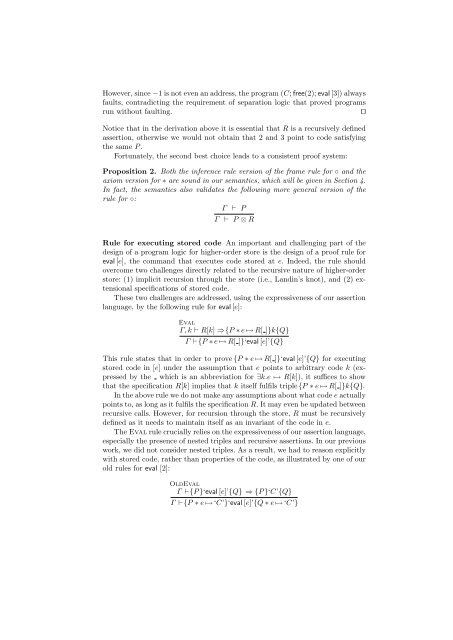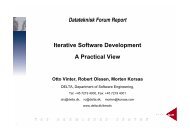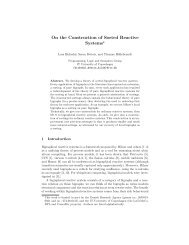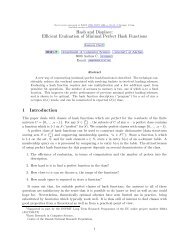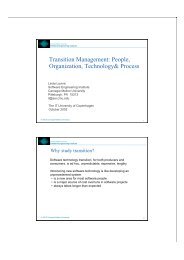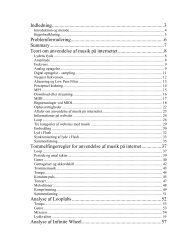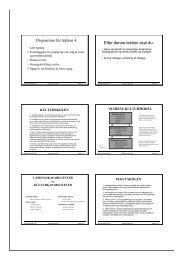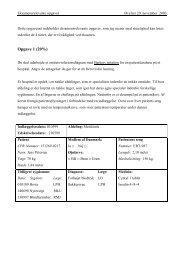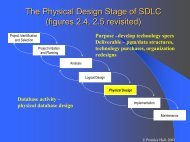Nested Hoare Triples and Frame Rules for Higher-order Store
Nested Hoare Triples and Frame Rules for Higher-order Store
Nested Hoare Triples and Frame Rules for Higher-order Store
Create successful ePaper yourself
Turn your PDF publications into a flip-book with our unique Google optimized e-Paper software.
However, since −1 is not even an address, the program (C; free(2); eval [3]) alwaysfaults, contradicting the requirement of separation logic that proved programsrun without faulting.⊓⊔Notice that in the derivation above it is essential that R is a recursively definedassertion, otherwise we would not obtain that 2 <strong>and</strong> 3 point to code satisfyingthe same P .Fortunately, the second best choice leads to a consistent proof system:Proposition 2. Both the inference rule version of the frame rule <strong>for</strong> ◦ <strong>and</strong> theaxiom version <strong>for</strong> ∗ are sound in our semantics, which will be given in Section 4.In fact, the semantics also validates the following more general version of therule <strong>for</strong> ◦:Γ ⊢ PΓ ⊢ P ⊗ RRule <strong>for</strong> executing stored code An important <strong>and</strong> challenging part of thedesign of a program logic <strong>for</strong> higher-<strong>order</strong> store is the design of a proof rule <strong>for</strong>eval [e], the comm<strong>and</strong> that executes code stored at e. Indeed, the rule shouldovercome two challenges directly related to the recursive nature of higher-<strong>order</strong>store: (1) implicit recursion through the store (i.e., L<strong>and</strong>in’s knot), <strong>and</strong> (2) extensionalspecifications of stored code.These two challenges are addressed, using the expressiveness of our assertionlanguage, by the following rule <strong>for</strong> eval [e]:EvalΓ, k ⊢ R[k] ⇒{P ∗ e ↦→ R[ ]}k{Q}Γ ⊢{P ∗ e ↦→ R[ ]}‘eval [e]’{Q}This rule states that in <strong>order</strong> to prove {P ∗ e ↦→ R[ ]}‘eval [e]’{Q} <strong>for</strong> executingstored code in [e] under the assumption that e points to arbitrary code k (expressedby the which is an abbreviation <strong>for</strong> ∃k.e ↦→ R[k]), it suffices to showthat the specification R[k] implies that k itself fulfils triple{P ∗ e ↦→ R[ ]}k{Q}.In the above rule we do not make any assumptions about what code e actuallypoints to, as long as it fulfils the specification R. It may even be updated betweenrecursive calls. However, <strong>for</strong> recursion through the store, R must be recursivelydefined as it needs to maintain itself as an invariant of the code in e.The Eval rule crucially relies on the expressiveness of our assertion language,especially the presence of nested triples <strong>and</strong> recursive assertions. In our previouswork, we did not consider nested triples. As a result, we had to reason explicitlywith stored code, rather than properties of the code, as illustrated by one of ourold rules <strong>for</strong> eval [2]:OldEvalΓ ⊢{P }‘eval [e]’{Q} ⇒ {P }‘C’{Q}Γ ⊢{P ∗ e ↦→ ‘C’}‘eval [e]’{Q ∗ e ↦→ ‘C’}


